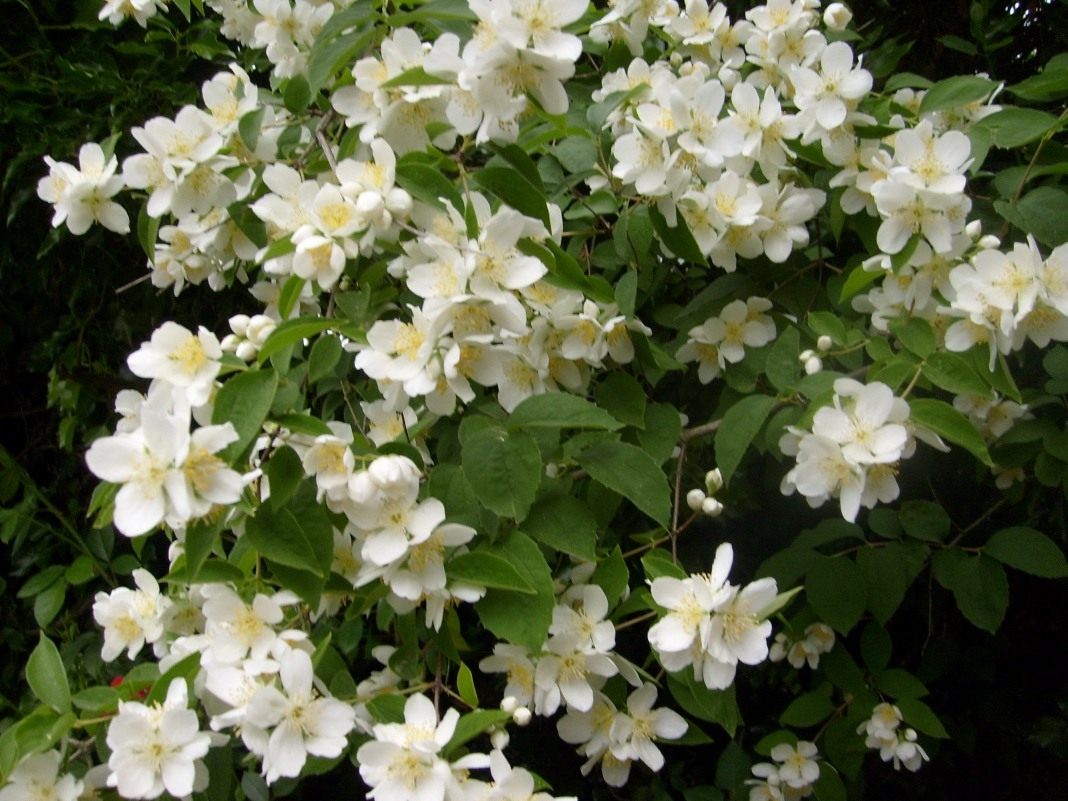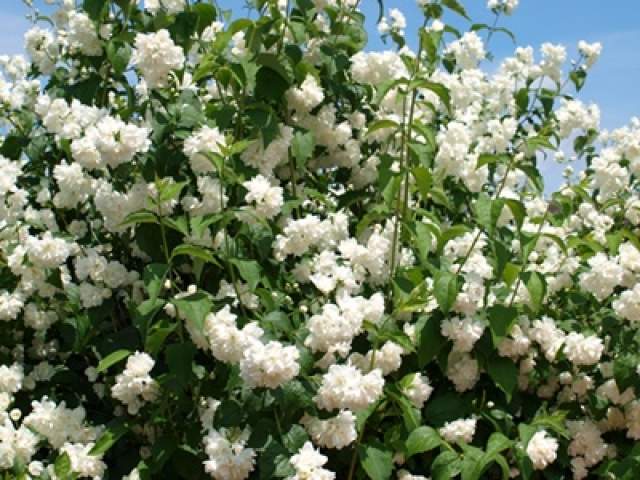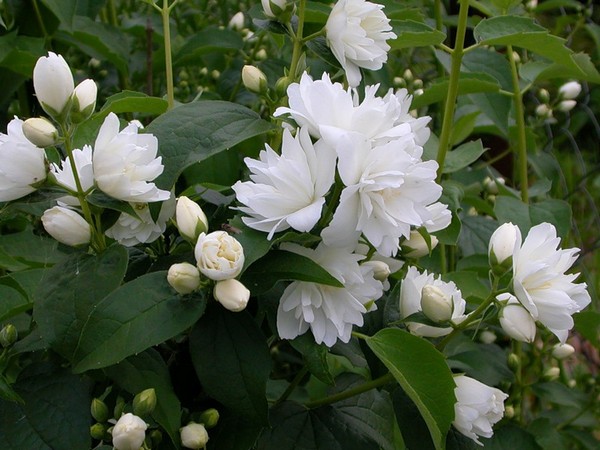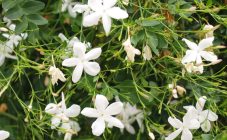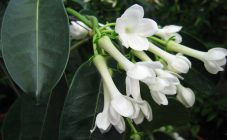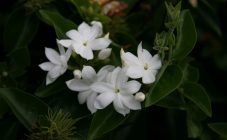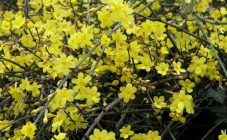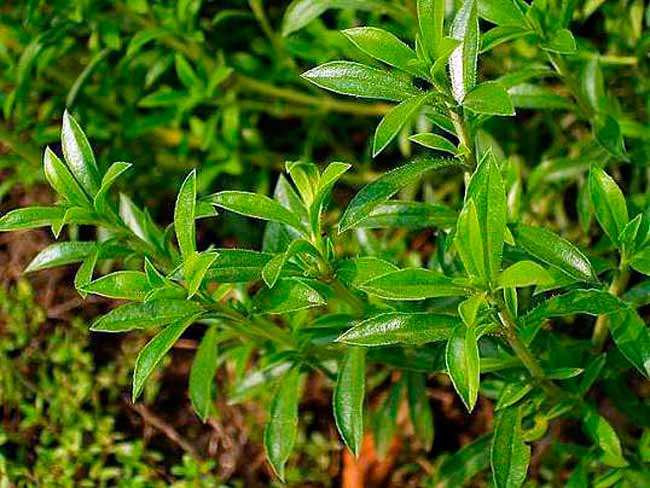Content:
One of the popular garden plants is garden jasmine. During flowering, the pleasant and memorable scent of beautiful white shrub flowers fills the entire garden area. This plant is equally suitable for home decoration as an indoor flower and for growing outdoors.
What is the difference between jasmine and chubushnik
What is the difference between jasmine and mock orange? Chubushnik (garden jasmine) belongs to the Hortensiev family. Among flowering shrubs in Russia, it is as popular as lilacs or roses. Such an interesting name appeared due to the ancient use of the wood of this plant for the manufacture of one of the elements of smoking pipes - shanks. The Latin name adopted in botany is philadelphus. The flowering time of the shrub is spring, early summer. The peculiarity of garden jasmine is its unpretentiousness and the ability to adapt to difficult weather conditions.
Jasmine belongs to the Olive family and its name comes from the Persian word "yasemin". It is an evergreen vine with very fragrant flowers. The pleasant scent of beautiful white jasmine flowers makes it similar to a mock orange.
Another difference is that real jasmine cannot withstand northern winters. In the middle lane, it is better to grow it at home as a houseplant.
Plant characteristic
Garden jasmine is a deciduous shrub. It has erect shoots that are covered with a thin brown or gray bark. The snow-white or creamy mock-orange flowers are endowed with essential oils that give the plant a pleasant aroma. They have healing properties. Decoctions from flowers are useful, they normalize digestion and bowel function, have immunomodulatory properties.
Types and varieties of garden jasmine
There are many types of chubushnik. There are over 60 species in the wild. Sadovykh - about 30 and quite a few derivatives from them. Each type of jasmine has its own unique aroma. Some representatives of this genus have no smell at all; some flowers have a scent that resembles citrus fruits or strawberries.
The most commonly cultivated species of mock-orange in Russia are:
- small-leaved;
- coronary;
- fluffy.
Small-leaved chubushnik
A relatively small shrub. Its height does not exceed 100 cm. The leaves are large and slightly curved. The flowers have a very pleasant scent that resembles the smell of strawberries.
Coronal chubushnik
Quite a large bush. Its height reaches 3 m. Its inflorescences are very large, with a pleasant, slightly sweet smell. The leaves have a very beautiful golden hue.
Fluffy chubushnik
Usually planted in parks or summer cottages, large garden plots. The plant reaches a height of 4 m - this is the highest variety of mock-orange. Its peculiarity is long flowering, which lasts more than 4 weeks, as well as the absence of smell in flowers.
Chubushnik has many breeding varieties. For example, some of the most famous:
- Gornostaeva Mantya is a very compact bush, no more than 1 m high. The plant is very beautiful during flowering, since the flowers are located along the entire length of the branches. It blooms for a long time - for 8 weeks.
- The Airborne variety is distinguished by unusual colors that resemble parachutes.The shape of the bush is pyramidal. Height - more than 3 m. The smell resembles the aroma of strawberries. This strawberry scent makes the variety especially popular.
- The Unusual variety got its name because of the pinkish shade of flowers that is really unusual for garden jasmine, which have a not strong, but very delicate aroma. The bush is low, no more than one and a half meters high.
- The Snowbelle variety (in translation - snow beauty) is named so because of the snow-white color of large, beautiful, double flowers. The variety is frost-resistant and drought-resistant, perfectly tolerates the gas pollution of the air in large cities.
- Komsomolets belongs to the early, abundantly flowering varieties. Its main difference is double flowers. The variety is frost-resistant, does not need shelter for the winter.
Jasmine (chubushnik): care and cultivation in the garden
Cultivation of a chubushnik in a personal plot consists of simple agricultural techniques.
Planting a plant
Garden jasmine attracts flower growers not only for its beauty, but also for its unpretentiousness. For this shrub to grow better, you need to carefully approach the choice of a planting site. You need to plant the plant in nutrient-rich soil. It is important to know that jasmine does not tolerate excessively moist soil. Therefore, in depressions or lowlands where moisture accumulates, it is better not to plant it, hills are more like.
Drainage must be ensured during planting. To do this, sand is poured into the hole, which is mixed with small stones. For jasmine to take root better, you need to add 50 g of nitrophosphate to the hole. After planting is complete, the soil is compacted. Then it is important not to forget to water the newly planted plant.
Bush care after planting
Caring for garden jasmine involves feeding, pruning and proper preparation for winter. It is not difficult to take care of this plant, but it will thank you for the attention and care of the gardener with long, abundant flowering.
Pruning for the formation of a well-groomed type of shrub is best done in the spring. It is imperative to remove diseased, damaged branches. It is recommended to cut the longest branches completely, and the short ones should be shortened in half. The central trunk is also cut off: in an adult plant, it is shortened by 45-50 cm.
Garden jasmine needs regular feeding. The first time you need to apply fertilizer only a year after planting the plant in open ground. Chubushnik needs both mineral and organic fertilizers. Superphosphate can be used for mineral fertilization. To prepare the solution, it is necessary to observe the following proportions: take 5 g of superphosphate and dissolve it in 1 liter of water, then add 2.5 g of urea and the same amount of potassium sulfide. Mix all elements thoroughly. For feeding with organic fertilizers, both manure and humus are used.
Novice flower growers are often interested in why garden jasmine does not bloom. Most likely he lacks feeding.
Throughout the entire growing season of a jasmine plant, it is necessary to monitor the condition of the soil. There should be no drying out, you need to periodically water the plant and renew the mulching layer.
Sometimes gardeners are worried about why garden jasmine does not bloom if feeding and pruning are done on time and correctly. The reason may be:
- viral diseases;
- plant damage by a fungus;
A sign of viral or fungal diseases can be spots on the aboveground organs, dried leaves appear, although watering is carried out regularly. After identifying the cause of the disease, you need to immediately start treating the plant.If this is a fungal or bacterial infection, the bush should be treated with fungicides or insecticides (depending on the type of infection), but if the cause of the disease is a virus, the plant must be destroyed before the infection affects other crops.
Chubushnik is not a relative of jasmine, but at the same time it has no less positive qualities. With a little effort and time, you can grow a wonderful ornamental shrub in your garden, which will bloom with snow-white fragrant flowers every season.
